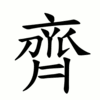齊
| ||||||||
| ||||||||
Translingual
| Stroke order | |||
|---|---|---|---|
 | |||
| Traditional | 齊 |
|---|---|
| Shinjitai | 斉 |
| Simplified | 齐 |
Han character
齊 (Kangxi radical 210, 齊+0, 14 strokes, cangjie input 卜X (YX), four-corner 00223, composition ⿳亠⿲刀丫⿸⿱丿𠄌㇏⿲丿二丨)
- Kangxi radical #210, ⿑.
Derived characters
References
- KangXi: page 1531, character 6
- Dai Kanwa Jiten: character 48560
- Dae Jaweon: page 2068, character 11
- Hanyu Da Zidian (first edition): volume 7, page 4783, character 1
- Unihan data for U+9F4A
Chinese
Glyph origin
| Historical forms of the character 齊 |
|---|
| Shuowen Jiezi (compiled in Han) |
| Small seal script |
 |
Characters in the same phonetic series (齊) (Zhengzhang, 2003)
| Old Chinese | |
|---|---|
| 儕 | *zriːl |
| 麡 | *zriːl, *ʔsliːl, *zliːl |
| 齋 | *ʔsriːl |
| 穧 | *ʔsleds, *ʔsliːls, *zliːls |
| 擠 | *ʔsliːl, *ʔsliːls |
| 躋 | *ʔsliːl, *ʔsliːls |
| 齏 | *ʔsliːl |
| 齎 | *ʔsliːl, *ʔslil |
| 櫅 | *ʔsliːl |
| 齌 | *ʔsliːl, *sʰliːl, *zliːls |
| 隮 | *ʔsliːl, *ʔsliːls |
| 賷 | *ʔsliːl |
| 虀 | *ʔsliːl |
| 濟 | *ʔsliːlʔ, *ʔsliːls |
| 癠 | *ʔsliːlʔ, *zliːl, *zliːlʔ, *zliːls |
| 霽 | *ʔsliːls |
| 齊 | *zliːl, *zliːls |
| 臍 | *zliːl |
| 蠐 | *zliːl, *zlil |
| 懠 | *zliːl, *zliːls |
| 薺 | *zliːlʔ, *zlil |
| 鱭 | *zliːlʔ |
| 嚌 | *zliːls |
| 劑 | *zliːls, *ʔslel |
| 齍 | *ʔslil |
Ideogram (指事) : a field of grain, hence of uniform height.
Etymology 1
| trad. | 齊 | |
|---|---|---|
| simp. | 齐 | |
| alternative forms | ||
Either related to Mizo čelʔᴸ (“equal, to endure”) or, more phonologically likely, Tibetan ཚིར (tshir, “queue, order, succession”) as Tibetan /tsʰir/'s final /-r/ can explain the Middle Chinese retroflex initial of 儕 (OC *zriːl), which is derived from 齊 (OC *zliːl).
Pronunciation 1
Definitions
齊
- even; uniform; of equal length
- same; identical
- 「見賢思齊焉,見不賢而內自省也。」 [Classical Chinese, trad.]
- From: The Analects of Confucius, c. 475 – 221 BCE, translated based on James Legge's version
- “jiànxiánsīqí yān, jiàn bù xián ér nèi zì xǐng yě.” [Pinyin]
- "When we see men of worth, we should think of equaling them; when we see men of a contrary character, we should turn inwards and examine ourselves."
“见贤思齐焉,见不贤而内自省也。” [Classical Chinese, simp.]
- complete
- together; simultaneously
- to be the same height as; to be level with
- along a line
- (~國) Qi, an ancient Chinese duchy, and later kingdom, during the Zhou dynasty
- Southern Qi (479–502), the second of the Southern dynasties in China
- Northern Qi (550–577), one of the Northern dynasties in China
- 齊朝有一士大夫,嘗謂吾曰:「我有一兒,年已十七,頗曉書疏,教其鮮卑語及彈琵琶,稍欲通解,以此伏事公卿,無不寵愛,亦要事也。」 [Literary Chinese, trad.]
- From: Yan Zhitui, The Family Instructions of Master Yan, 6th century CE
- Qí cháo yǒu yī shìdàfū, cháng wèi wú yuē: “Wǒ yǒu yī ér, nián yǐ shíqī, pō xiǎo shūshū, jiào qí xiānbēiyǔ jí tán pípá, shāo yù tōngjiě, yǐ cǐ fúshì gōngqīng, wú bù chǒng'ài, yì yàoshì yě.” [Pinyin]
- There is a scholar-official in the Qi Dynasty, who once said to me, "I have a son who is seventeen years of age and is well versed in writing official reports. I taught him the Xianbei language and how to play the pipa, and when he became somewhat capable in those, he began serving the officials and was loved by all. These are important things."
齐朝有一士大夫,尝谓吾曰:“我有一儿,年已十七,颇晓书疏,教其鲜卑语及弹琵琶,稍欲通解,以此伏事公卿,无不宠爱,亦要事也。” [Literary Chinese, simp.]
- (~日) (telegraphy) the eighth day of a month
- alternative form of 奇
- a surname
Compounds
Derived terms from 齊
|
|
|
Pronunciation 2
Pronunciation 3
Pronunciation 4
Compounds
|
|
Pronunciation 5
Compounds
|
|
|
Pronunciation 6
Pronunciation
References
- “齊”, in 漢語多功能字庫 (Multi-function Chinese Character Database), 香港中文大學 (the Chinese University of Hong Kong), 2014–
- Dictionary of Chinese Character Variants (教育部異體字字典), A04794
- “Entry #10973”, in 臺灣閩南語常用詞辭典 [Dictionary of Frequently-Used Taiwan Minnan] (in Chinese and Min Nan), Ministry of Education, R.O.C., 2011.
Japanese
| 斉 | |
| 齊 |
Kanji
齊
(“Jinmeiyō” kanji used for names, kyūjitai kanji, shinjitai form 斉)
- This term needs a translation to English. Please help out and add a translation, then remove the text
{{rfdef}}.
Readings
- Go-on: ざい (zai); し (shi)
- Kan-on: せい (sei); し (shi)
- Kan’yō-on: さい (sai)
- Kun: そろう (sorō, 齊う)←そろふ (sorofu, 齊ふ, historical); そろえる (soroeru, 齊える)←そろへる (soroferu, 齊へる, historical); ととのう (totonō, 齊う)←ととのふ (totonofu, 齊ふ, historical); ととのえる (totonoeru, 齊える)←ととのへる (totonoferu, 齊へる, historical); ひとしい (hitoshii, 齊しい)
- Nanori: きよ (kiyo); ただ (tada); ただし (tadashi); とき (toki); とし (toshi); なお (nao)←なほ (nafo, historical); なり (nari); ひさし (hisashi); まさ (masa); むね (mune); よし (yoshi)
Korean
Hanja
齊 (eum 제 (je))
- This term needs a translation to English. Please help out and add a translation, then remove the text
{{rfdef}}.
Vietnamese
References
This article is issued from Wiktionary. The text is licensed under Creative Commons - Attribution - Sharealike. Additional terms may apply for the media files.